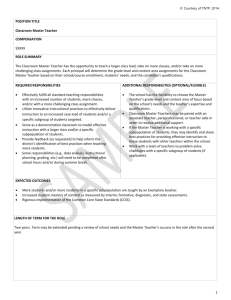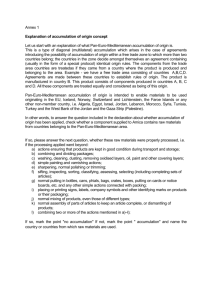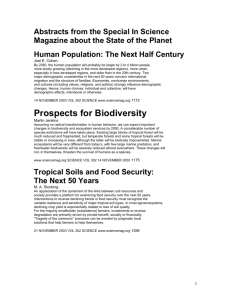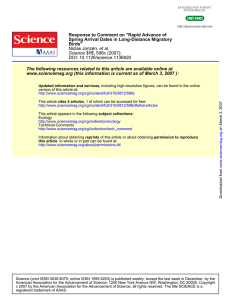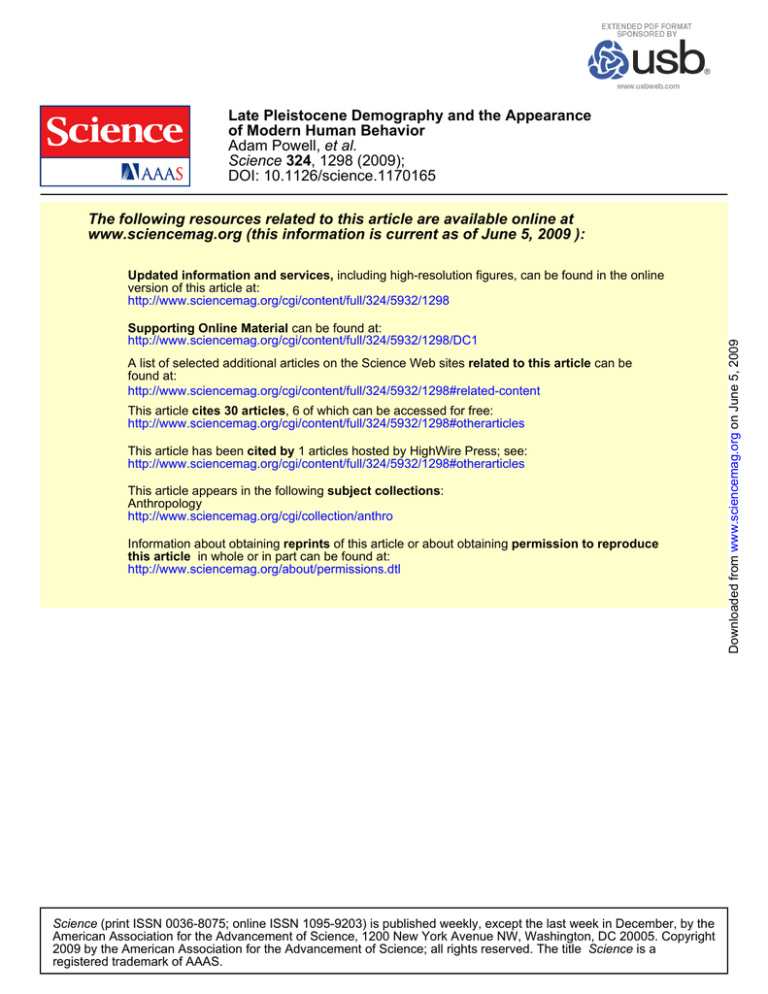
Late Pleistocene Demography and the Appearance
of Modern Human Behavior
Adam Powell, et al.
Science 324, 1298 (2009);
DOI: 10.1126/science.1170165
The following resources related to this article are available online at
www.sciencemag.org (this information is current as of June 5, 2009 ):
Supporting Online Material can be found at:
http://www.sciencemag.org/cgi/content/full/324/5932/1298/DC1
A list of selected additional articles on the Science Web sites related to this article can be
found at:
http://www.sciencemag.org/cgi/content/full/324/5932/1298#related-content
This article cites 30 articles, 6 of which can be accessed for free:
http://www.sciencemag.org/cgi/content/full/324/5932/1298#otherarticles
This article has been cited by 1 articles hosted by HighWire Press; see:
http://www.sciencemag.org/cgi/content/full/324/5932/1298#otherarticles
This article appears in the following subject collections:
Anthropology
http://www.sciencemag.org/cgi/collection/anthro
Information about obtaining reprints of this article or about obtaining permission to reproduce
this article in whole or in part can be found at:
http://www.sciencemag.org/about/permissions.dtl
Science (print ISSN 0036-8075; online ISSN 1095-9203) is published weekly, except the last week in December, by the
American Association for the Advancement of Science, 1200 New York Avenue NW, Washington, DC 20005. Copyright
2009 by the American Association for the Advancement of Science; all rights reserved. The title Science is a
registered trademark of AAAS.
Downloaded from www.sciencemag.org on June 5, 2009
Updated information and services, including high-resolution figures, can be found in the online
version of this article at:
http://www.sciencemag.org/cgi/content/full/324/5932/1298
21. J. Woodburn, in Death and the Regeneration of Life,
M. Bloch, J. Parry, Eds. (Cambridge Univ. Press,
Cambridge, 1982), pp. 187–210.
22. J. M. Tenney, Hum. Evol. 5, 397 (1990).
23. P. Lambert, in Troubled Times: Violence and Warfare in
the Past, D. L. Martin, D. W. Frayer, Eds. (Gordon &
Breach, Amsterdam, 1997), pp. 77–109.
24. G. Milner, Am. Antiq. 70, 144 (2005).
25. J. H. Bill, Am. J. Med. Sci. 40, 365 (1862).
26. J. Morgan, The Life and Adventures of William Buckley:
Thirty-Two Years a Wanderer Amongst the Aborigines
[Australia National Univ. Press (first published 1852),
Canberra, 1979].
27. J. Melbye, S. Fairgrieve, Arctic Anthropol. 31, 57
(1994).
28. I. Schapera, The Khoisan Peoples of South Africa
(Routledge & Kegan Paul, London, 1930).
29. C. Campbell, World Archaeol. 18, 255 (1986).
30. L. Jost, Mol. Ecol. 17, 4015 (2008).
31. P. W. Hedrick, Evolution 59, 1633 (2005).
32. H. Lourandos, Continent of Hunter-Gatherers (Cambridge
Univ. Press, Cambridge, 1997).
33. P. Tacon, C. Chippendale, Camb. Archaeol. J. 4, 211
(1994).
34. S. J. Walsh, R. J. Mitchell, N. Watson, J. S. Buckleton.
J. Hum. Genet. 52, 712 (2007).
35. J.-P. Bocquet-Appel, P.-Y. Demars, L. Noiret, D. Dobrowsky,
J. Archaeol. Sci. 32, 1656 (2005).
36. M. N. Cohen, in Biosocial Mechanisms of Population
Regulation, M. N. Cohen, R. S. Malpass, H. G. Klein,
Eds. (Yale Univ. Press, New Haven, CT, 1980), pp. 275–303.
37. F. A. Hassan, in Biosocial Mechanisms of Population
Regulation, M. N. Cohen, R. S. Malpass, H. G. Klein, Eds.
(Yale Univ. Press, New Haven, CT, 1980), pp. 305–319.
38. S. R. Johansson, S. R. Horowitz, Am. J. Phys. Anthropol.
71, 233 (1986).
39. North Greenland Ice Core Project members, Nature 431,
147 (2004).
40. C. Ember, M. Ember, J. Conflict Resolut. 36, 242 (1992).
41. F. Wendorf, Prehistory of Nubia (Southern Methodist
Univ. Press, Dallas, TX, 1968).
42. R. W. Wrangham, M. L. Wilson, M. N. Muller, Primates
47, 14 (2006).
43. T. L. Goldberg, L, M. Ruvolo. Mol. Biol. Evol. 14, 976 (1997).
44. F. Marlowe, Evol. Anthropol. 14, 54 (2005).
45. F. W. Lanchester, Aircraft in Warfare, the Dawn of
the Fourth Arm (Constable & Co., Ltd., Tiptee, UK, 1916),
p. 222.
46. Thanks to I. Levina and A. Verashchagina for translating
the Russian and Ukrainian archaeological materials;
P. Lambert and K. Kennedy for assistance with the
Californian and Indian archaeological evidence;
M. Alexander, K. Ames, B. Bertram, L. Luigi Cavalli-Sforza,
T. Clutton-Brock, W. Cote, E. Einhorn, D. Wood Gordon,
H. Kaplan, K. Hill, K. Howard, S.-H. Hwang,
K. Langergraber, S. Le Blanc, J. Mitani, C. Resnicke,
R. Rowthorn, P. Seabright, E. Alden Smith, T. Taylor,
D. Ulibarri, L. Vigilant, E. Wood, and R. Wrangham for
valuable contributions; and the Behavioral Sciences
Program of the Santa Fe Institute, the U.S. National
Science Foundation, the European Science Foundation,
and the University of Siena for support of this work.
The author declares no competing interests.
Supporting Online Material
www.sciencemag.org/cgi/content/full/324/5932/1293/DC1
Materials and Methods
Tables S1 to S5
References and Notes
5 November 2008; accepted 10 April 2009
10.1126/science.1168112
REPORTS
Late Pleistocene Demography and
the Appearance of Modern
Human Behavior
Adam Powell,1,3 Stephen Shennan,2,3 Mark G. Thomas1,3*
The origins of modern human behavior are marked by increased symbolic and technological
complexity in the archaeological record. In western Eurasia this transition, the Upper Paleolithic,
occurred about 45,000 years ago, but many of its features appear transiently in southern Africa
about 45,000 years earlier. We show that demography is a major determinant in the maintenance
of cultural complexity and that variation in regional subpopulation density and/or migratory
activity results in spatial structuring of cultural skill accumulation. Genetic estimates of regional
population size over time show that densities in early Upper Paleolithic Europe were similar to
those in sub-Saharan Africa when modern behavior first appeared. Demographic factors can thus
explain geographic variation in the timing of the first appearance of modern behavior without
invoking increased cognitive capacity.
he Upper Paleolithic (UP) transition,
which occurred in Europe and western
Asia about 45 thousand years ago (ka)
(1, 2), and later in southern and eastern Asia
(3, 4), Australia (5, 6), and Africa (7), is seen
by many as marking the origins of modern human behavior. UP material culture, usually
referred to as the Late Stone Age (LSA) in
Africa, is characterized by a substantial increase
in technological and cultural complexity, includ-
T
1298
ing the first consistent presence of symbolic behavior, such as abstract and realistic art and body
decoration (e.g., threaded shell beads, teeth, ivory,
ostrich egg shells, ochre, and tattoo kits); systematically produced microlithic stone tools (especially blades and burins); functional and ritual
bone, antler, and ivory artifacts; grinding and
pounding stone tools; improved hunting and trapping technology (e.g., spear throwers, bows, boomerangs, and nets); an increase in the long-distance
5 JUNE 2009
VOL 324
SCIENCE
transfer of raw materials; and musical instruments,
in the form of bone pipes (1, 2, 5, 7–9).
In Europe and western Asia, the UP transition
happened relatively rapidly, with most of the
characteristic features listed above appearing (the
“full package”), and is thought to coincide with
the appearance of anatomically modern humans
(AMH) in a region previously occupied by
Neandertals (10). In southern Siberia and northeast Asia, microlithic technology appears between 43 and 27 ka (11), but a fuller UP package
is not evident until ~22 ka (12). The evidence
from south and southeast Asia and Australia also
points to a more gradual accumulation of modern
behavioral traits (ornamentation, use of ochre,
and possibly rock art) (3–6). These are thought to
first appear soon after the initial expansions of
AMH into the regions but only become widespread later on, ~30 ka (4) and ~20 ka, if not later
(5), in south Asia and Australia, respectively. In
Africa, the idea of a single transition has been
1
Research Department of Genetics, Evolution, and Environment,
University College London, Wolfson House, 4 Stephenson Way,
London NW1 2HE, UK. 2Institute of Archaeology, University
College London, 31–34 Gordon Square, London WC1H 0PY, UK.
3
Arts and Humanities Research Council (AHRC) Centre for the
Evolution of Cultural Diversity, Institute of Archaeology,
University College London, 31–34 Gordon Square, London
WC1H 0PY, UK.
*To whom correspondence should be addressed. E-mail:
m.thomas@ucl.ac.uk
www.sciencemag.org
Downloaded from www.sciencemag.org on June 5, 2009
References and Notes
1. C. Darwin, The Descent of Man (D. Appleton & Co.,
New York, 1873).
2. A. Gat, War in Human Civilization (Oxford Univ. Press,
Oxford, 2006).
3. E. S. Burch, Alliance and Conflict: The World System of the
Unupiaq Eskimos (Univ. of Nebraska Press, Lincoln, NE, 2005).
4. S. A. LeBlanc, Constant Battles (St. Martins Press,
New York, 2003).
5. B. Ferguson, in Troubled Times: Violence and Warfare in
the Past, D. L. Martin, D. W. Frayer, Eds. (Gordon &
Breach, Amsterdam, 1997), pp. 321–354.
6. L. Keeley, War Before Civilization (Oxford Univ. Press,
New York, 1996).
7. K. Aoki, Evolution 36, 832 (1982).
8. S. A. Boorman, P. R. Levitt, Theor. Popul. Biol. 4, 85 (1973).
9. R. Andrés Guzmán, C. Rodríguez-Sickert, R. Rowthorn,
Evol. Hum. Behav. 28, 112 (2007).
10. S. Bowles, J.-K. Choi, A. Hopfensitz, J. Theor. Biol. 223,
135 (2003).
11. O. Smirnov, H. Arrow, D. J. Kennett, J. Orbell, J. Polit. 69,
927 (2007).
12. S. Bowles, Science 314, 1569 (2006).
13. J.-K. Choi, S. Bowles, Science 318, 636 (2007).
14. L. Lehmann, M. Feldman, Proc. R. Soc. London Ser. B.
Biol. Sci. 275, 2877 (2008).
15. V. Formicola, Curr. Anthropol. 48, 446 (2007).
16. J. H. Manson, R. W. Wrangham, Curr. Anthropol. 32, 369
(1991).
17. Methods and other supporting materials are available on
Science Online.
18. J. Williams, G. Oehlert, J. Carlis, A. E. Pusey, Anim. Behav.
68, 523 (2004).
19. B. Kerr, P. Godfrey-Smith, M. Feldman, Trends Ecol. Evol.
19, 135 (2004).
20. G. R. Price, Nature 227, 520 (1970).
contested (9) because there is strong evidence for
the sporadic appearance of many markers of modern behavior at multiple sites as early as 70 to 90 ka
(2, 9, 13), and possibly as far back as 160 ka (14).
The African Middle Stone Age (MSA) sites of
Katanda, Democratic Republic of Congo (~90 ka)
(9); Klasies River mouth (Howieson’s Poort and
Still Bay industries), South Africa (~65 to 70 ka)
(9, 15); and, in particular, Blombos Cave, South
Africa (~75 ka) (10, 13) present a striking array
of modern traits, including the earliest evidence
of abstract art (8, 13), as well as geometric blades,
barbed bone harpoon points (9), bone awls, and
marine shell personal ornaments (10). However,
these markers are intermittent and disappear between ~75 and 60 ka before making a more stable
and widespread reappearance in the LSA starting ~ 40 ka (7, 10, 13).
Notwithstanding the oversimplifications made
in the above outline, any adequate account of the
emergence of modern behavior would need to explain not only the transition itself but also its
heterogeneous spatial and temporal structuring (2)
and earlier transient appearance in sub-Saharan
Africa (9, 10, 13). It is now widely accepted that
AMH evolved in Africa ~160 to 200 ka (9, 16–18)
and expanded into most habitable parts of the Old
World between 90 and 40 ka (19–21). If, as some
have suggested (22–24), the main cause of behavioral modernity is heritable biological change
just before the UP/LSA, then any such mutation(s)
would have had to rise to substantial frequencies
after human populations had dispersed out of Africa;
implying either their rapid spread around the world
in the past 45,000 years or, potentially, geographic
structuring of cognitive capacity. Furthermore, it is
difficult to account for the southern African evidence with a late, biologically determined cognitive
advance. Many authors have argued that AMH
(1, 9, 10, 17, 20), and possibly even Neandertals
(8, 10), possessed the requisite capacities long
before the UP/LSA. This raises the further question of why there was a delay of some 100,000 years
between anatomical modernity and perceived behavioral modernity (1, 17). A number of mechanisms triggering the expression of modern behavior
have been proposed, many of which invoke demo-
graphic change as a causal factor. These include
expansion into new environments necessitating the
invention of new technologies (25), increased
subpopulation density escalating intergroup resource
competition (1, 25) or social organization (1), increased intergroup interaction requiring various cultural signaling mechanisms (6, 25, 26), and increased
stimulus for exoteric language (23, 27, 28). Two
recent cultural evolutionary models (29, 30), which
explicitly demonstrate the positive effect of increasing population size on the accumulation of beneficial
culturally inherited skills, have been proposed as an
integral explanatory component of the appearance of
modern behavior [see also (17)]. Here, we adapt and
extend Henrich’s transmission model (30) into a
more realistic structured metapopulation, which
reflects plausible late Pleistocene conditions, to
investigate the effects of demographic factors on
the accumulation (or loss) of cultural complexity.
Henrich’s model (30) demonstrates that under
certain critical conditions, directly biased transmission
can lead to cumulative adaptation of a culturally inherited skill, even when the transmission process is
inaccurate. Each individual in a population of size N
has a z value, zi, that measures their level of ability at
Downloaded from www.sciencemag.org on June 5, 2009
REPORTS
Fig. 1. Mean z values in the final (100th) generation,
averaged over 100 iterations, for a range of values of
skill complexity a and subpopulation density D.
Fig. 2. Regional mean z values (averaged over 100
iterations) over 100 generations in a heterogeneous
subpopulation density world. The 95% confidence
intervals for each region are given as dotted lines.
Fig. 3. An illustration, from a single iteration and shown at 25-generation intervals, of the spatial
structuring of skill accumulation in a heterogeneous subpopulation density world. The left side of each
subplot is populated at density Dhigh (0.02) and the right side at density Dlow (0.002). Each subpopulation
is marked by a circle, centered on the spatial location of the group and with diameter proportional to its
mean z value. Regional mean z values are also given at the top of each subplot.
www.sciencemag.org
SCIENCE
VOL 324
5 JUNE 2009
1299
some cultural skill or in some cultural domain.
Members of this population attempt to learn from
the maximally skilled individual (i.e., direct bias),
but an imperfect learning process leads on average
to a loss of skill (a reduction in z value), determined
by the parameter a. However, individual errors or
“inaccurate inferences” during transmission (the
extent of which are governed by a parameter b)
occasionally allow some learners to acquire a z
value greater than that of their model. Henrich
shows that as population size, N, increases, the
more likely it is that the positive combined effect of
these occasional inaccurate inferences and the
selective choice of cultural model to copy will outweigh the degrading effect of low-fidelity transmission. This results in an increase in the mean level of
skill in the population, z. He terms this “cumulative
adaptive evolution” and derives the critical population size necessary, N*, for this to occur for
specific ratios of a and b (30, 31).
We introduce a stochastic transmission model
analogous to the one presented by Henrich that
incorporates both vertical and skill-level dependent
oblique learning processes. We place individuals in
G subpopulations, each of size N, in a simulated
world at density D. These subpopulations are
connected by Gaussian random-walk migratory
activity, with standard deviation MSD, such that the
mean global migration rate approximates the
subpopulation density D (31). Where possible, we
use parameter values from ethnographic and
comparative behavioral studies that approximate
presumed late Pleistocene demography (31). We
initialize simulations by giving all adults in all
subpopulations a z value of 10.0 and run forward for
100 generations. The mean level of cultural skill
accumulation, z, is measured by averaging z values
across all individuals in all subpopulations. If the
mean z value in the final generation is greater than
10.0 (i.e., Dz > 0), then the result was deemed
“cumulatively adaptive.” To account for stochastic
variation in simulation outcomes, we performed
100 iterations and averaged the results across these.
We first explored the effects of varying the number of subpopulations in our simulated world, G, on
the mean level of cultural skill accumulated, z. For
values of G > ~50, the z value did not increase much
further across the entire range of subpopulation densities D and skill complexities a (fig. S1). Figure 1
illustrates that the degree of skill accumulation increased with increasing subpopulation density and
decreasing skill complexity. These results indicate
that the accumulation, or maintenance, of culturally
inherited skill is not dependent on the absolute metapopulation size, but rather on the degree of interaction
of the constituent subpopulations, given population
substructure and that G > ~50. However, when G <
~50, skill accumulation will, to an extent, be dependent on G, and thus the size of the metapopulation.
This result may have some bearing on debate concerning the erosion of cultural complexity in Holocene
Tasmania (30, 32, 33). As a conservative measure, we
fixed G at 100 in all subsequent simulations.
A key feature of the UP is the geographic heterogeneity in apparent onset times, despite different
1300
regions being mutually accessible with modest migration activity. To investigate whether skill accumulation can be spatially structured as a result of
different subpopulation densities, we partitioned our
simulated world into two regions differing in density
by an order of magnitude, Dhigh and Dlow. We retained MSD at 1.0, but as a proportion of the mean
nearest neighbor distance, rE , in the lower density
region (31). This ensured that sufficient subpopulations were connected by migratory activity—
including across the partition—for the migration
rate to approximate the density in each region. We
set Dhigh = 0.02 and Dlow = 0.002 and simulated a
range of a values (2.0 to 4.0). For all a values, we
found that skill accumulation is consistently higher in the Dhigh region even though the two regions
were contiguous. As an example, when we fixed a =
3.0, this difference in mean regional z values, averaged over 100 iterations, was maintained over
the entire duration of the simulation (Fig. 2).
Figure 3 and movie S1 provide an illustration
from a single iteration of the spatial structuring of
skill accumulation.
We would also expect heterogeneity in migratory range during the late Pleistocene due to, for
example, differing terrains, vegetation, or subsistence
strategies (4). To investigate whether this could result
in spatial structuring of skill accumulation, we populated the simulated world at a constant subpopulation density D = 0.01 and partitioned it into two
regions with differing MSD values (31); MSD,high =
1.0 and MSD,low = 0.1, allowing migratory activity
across the partition. Similarly to the heterogeneous
density world, we find that skill accumulation was
consistently higher in the well-connected MSD,high
region across all a values simulated (2.0 to 4.0). An
example, with D = 0.01 and a = 2.9, is given in fig.
S2, with mean regional z values averaged over 100
iterations. Fig. S3 and movie S2 provide a spatial
illustration from a single iteration.
From the above results, it is clear that migratory
activity among a set of subpopulations can have the
same effect on skill accumulation as increasing the
size of a single population (30). This is because it
increases the within-group variance in skill levels,
zi, which feeds the selective directly biased transmission process and offsets the eroding effect of
low-fidelity transmission. We therefore sought to
quantify the effect of increasing migration activity
in terms of the effective number of adult individuals available as transmission models within
each subpopulation. To achieve this, we inverted
the previous simulation process; for given values
of a and D, we simulated widely over N to find
the minimum number of adults, Nmin, needed in
each subpopulation for adaptive cumulative evolution to occur (Fig. 4). We repeated this process for
the same range of a, but with no migratory process
operating, to obtain the minimum number of adults
required for skill accumulation in an isolated subpopulation, N0, for each value of a (Fig. 4) [this is
directly equivalent to Henrich’s analytical result (30)
but uses the extended transmission process presented in our study]. We then calculated the effective
increase in N due to migratory activity by finding
the difference between the Nmin we expect for given
values of a and D, and the N0 we expect for the
same value of a. As can be seen from Fig. 4, not
only does increasing migratory activity have the
same effect as increasing the size of an isolated
population (30), but also this effect is greater for
higher skill complexities, a.
Our simulation results demonstrate that the
influence of demography on cultural transmission
Fig. 4. The effective increase in adult subpopulation size due to migratory activity. (A) The minimum
number of adults required for adaptive cumulative evolution to occur, Nmin, for a range of values for
subpopulation density D and skill complexity a. (B) The minimum number of adults needed in a single
isolated population N0 for the same range of a values. (C) The effective increase in adult subpopulation
size N due to migratory activity for this range of D and a, calculated by subtracting surface (A) from curve
(B) extended along the D axis. The axes of (C) have been rotated for display purposes.
5 JUNE 2009
VOL 324
SCIENCE
www.sciencemag.org
Downloaded from www.sciencemag.org on June 5, 2009
REPORTS
REPORTS
Asian geographic regions (34). Performing Bayesian coalescent inference (34) on such structured data
sets is likely to have resulted in an overestimation of
the effective population size and the time at which
population expansion took place. In addition, coalescence date estimates for major mtDNA haplogroups in southern Asia have been interpreted as
reflecting an initial phase of population growth
somewhat later (37). A second possible explanation
for this anomalous result is that, although population
density may have been sufficiently high for behaviorally modern traits to otherwise accumulate,
the migratory range may have been insufficient to
allow wide-scale interaction between subpopulations. This may have been the case in southern Asia
during the later Pleistocene (4).
Although the inferred population densities
(34) could account for the early appearance of
behaviorally modern traits in sub-Saharan Africa
and the Middle East—given our demographic
model of cultural skill accumulation—they cannot explain the subsequent absence of these
features between 70 and ~40 ka because no
population size reduction during this period
is inferred [see figure 1 in (34)]. However, the
method of coalescent inference used (Bayesian
skyline analysis) may be unable to accurately
reconstruct more complex demographic histories
when using sequences sampled from a single
locus (38), so repeated bottlenecks and/or expansions, which would have an important bearing on the accumulation of culturally inherited
skills (17), may not be recaptured. Paleoclimatic
data does indicate worsening conditions during
oxygen isotope stage 4 (~75 to 60 ka) (21)—
possibly leading to population decline, fragmentation, and range contractions—during this period (20, 21). Lahr and Foley (20) suggest that
continent-wide secondary population bottlenecks
may have occurred ~70 ka, and there is some
evidence that the sites of the South African
Howieson’s Poort industries became effectively
depopulated by ~60 ka (15, 20).
We would expect a degree of positive feedback on population density after the accumulation of culturally inherited skills; the development
of more advanced technologies, and possibly social
organization, would likely lead to population
growth. Furthermore, we would expect to see more
artifactual evidence of behavioral modernity in
higher population density contexts through
increased deposition. Although the model we have
presented does not accommodate these processes or
explain the necessary cognitive developments that
make possible the invention or improvement of
complex behavioral traits, it does provide a
demographic mechanism for limiting the degree to
which early human populations would have
accumulated these culturally inherited skills over
time. Our model provides a plausible explanation
for the spatial and temporal structuring of the
markers of modern behavior in the paleoanthropological record, even if all AMH had the requisite
biologically determined cognitive capacities from
the time of origin some 160 to 200 ka.
www.sciencemag.org
SCIENCE
VOL 324
References and Notes
1. P. Mellars, Evol. Anthropol. 14, 12 (2005).
2. O. Bar-Yosef, Annu. Rev. Anthropol. 31, 363 (2002).
3. M. D. Petraglia, in Rethinking the Human Revolution,
P. Mellars, K. Boyle, O. Bar-Yosef, C. Stringer, Eds.
(McDonald Institute for Archaeological Research,
Univ. of Cambridge, Cambridge, 2007), pp. 383–394.
4. H. V. A. James, M. D. Petraglia, Curr. Anthropol. 46,
(suppl.), 3 (2005).
5. A. Brumm, M. W. Moore, Camb. Archaeol. J. 15, 157 (2005).
6. J. F. O’Connell, J. Allen, in Rethinking the Human
Revolution, P. Mellars, K. Boyle, O. Bar-Yosef, C. Stringer,
Eds. (McDonald Institute for Archaeological Research,
Univ. of Cambridge, Cambridge, 2007), pp. 395–410.
7. S. H. Ambrose, J. Archaeol. Sci. 25, 377 (1998).
8. F. d’Errico et al., J. World Prehist. 17, 1 (2003).
9. S. McBrearty, A. S. Brooks, J. Hum. Evol. 39, 453 (2000).
10. J. Zilhão, J. Archaeol. Res. 15, 1 (2007).
11. P. J. Brantingham, A. I. Krivoshapkin, L. Jinzeng,
Y. Tserendagva, Curr. Anthropol. 42, 735 (2001).
12. P. J. Brantingham, K. W. Kerry, A. I. Krivoshapkin,
Y. V. Kuzmin, in Entering America: Northeast Asia and
Beringia Before the Last Glacial Maximum, D. B. Madsen,
Ed. (Univ. of Utah Press, Salt Lake City, UT, 2004),
pp. 255–283.
13. C. S. Henshilwood et al., Science 295, 1278 (2002).
14. C. W. Marean et al., Nature 449, 905 (2007).
15. Z. Jacobs et al., Science 322, 733 (2008).
16. I. McDougall, F. H. Brown, J. G. Fleagle, Nature 433, 733 (2005).
17. C. Stringer, in Rethinking the Human Revolution,
P. Mellars, K. Boyle, O. Bar-Yosef, C. Stringer,
Eds. (McDonald Institute for Archaeological Research,
Univ. of Cambridge, Cambridge, 2007), pp. 15–20.
18. T. D. White et al., Nature 423, 742 (2003).
19. N. Ray, M. Currat, P. Berthier, L. Excoffier, Genome Res.
15, 1161 (2005).
20. M. M. Lahr, R. A. Foley, Am. J. Phys. Anthropol. Suppl.
27, 137 (1998).
21. S. H. Ambrose, J. Hum. Evol. 34, 623 (1998).
22. R. G. Klein, Evol. Anthropol. 9, 17 (2000).
23. N. Chomsky, Linguistic Enquiry 36, 1 (2005).
24. S. J. Mithen, The Prehistory of the Mind: A Search for the
Origins of Art, Religion, and Science (Thames &
Hudson, London, 1996).
25. M. C. Stiner, S. L. Kuhn, Hum. Ecol. 34, 693 (2006).
26. M. Vanhaeren, in From Tools to Symbols from Early
Hominids to Humans, F. d’Errico, L. Blackwell, Eds.
(Wits Univ. Press, Johannesburg, 2005), pp. 525–553.
27. J. Bolender, Biol. Philos. 22, 383 (2007).
28. D. Everett, Curr. Anthropol. 46, 621 (2005).
29. S. J. Shennan, Camb. Archaeol. J. 11, 5 (2001).
30. J. Henrich, Am. Antiq. 69, 197 (2004).
31. Materials and methods are available as supporting
material on Science Online.
32. D. Read, Am. Antiq. 71, 164 (2006).
33. J. Henrich, Am. Antiq. 71, 771 (2006).
34. Q. D. Atkinson, R. D. Gray, A. J. Drummond, Mol. Biol.
Evol. 25, 468 (2008).
35. N. A. Rosenberg et al., Science 298, 2381 (2002).
36. J. Z. Li et al., Science 319, 1100 (2008).
37. C. Sun et al., Mol. Biol. Evol. 23, 683 (2006).
38. A. J. Drummond, “Reconstructing evolutionary
bottlenecks using the coalescent,” http://bioinf.cs.
auckland.ac.nz/index.php/2008/03/02/the-coalescent-forbottlenecks (2008).
39. We thank J. Henrich, P. Richerson, K. Laland, A. Bentley,
T. Kivisild, T. Sumner, F. d’Errico, and C. Stringer for
discussion, and Q. Atkinson for making data available. This
work was supported by an AHRC Centre for the Evolution
of Cultural Diversity studentship awarded to A.P. and a
Wissenschaftskolleg zu Berlin fellowship awarded to M.G.T.
Downloaded from www.sciencemag.org on June 5, 2009
processes provides a mechanism to explain three
key features of the emergence of modern behavior
in the archaeological record: the early appearance,
and subsequent disappearance, of many modern
traits in Southern Africa 90 to 70 ka; geographical
heterogeneity in the timing of the UP outside Africa;
and the delay between the emergence of AMH as a
species and the material expression of modern behavioral traits. If, as proposed here, demographic
factors are fundamental in shaping the evolution of
human behavior, then well-supported estimates of
late Pleistocene regional population densities will be
crucial to understanding the UP/LSA. Recent estimates of population size changes in the late
Pleistocene—based on a Bayesian coalescent inference method with a global data set of coding-region
mitochondrial DNA (mtDNA) sequences (34)—
permit some comparisons of relative effective population densities in different regions of the world and
at different times.
By setting the UP transition in Europe at 45 ka
(1, 2), we can infer the critical effective population
size, and therefore density, necessary for the accumulation of markers of modern behavior. Although
this transition is closely associated with the initial
colonization by AMH, the rapid rise in skill levels
under favorable demographic conditions that we
observe in our simulations indicates that cultural
intensification would be largely insensitive to the
time since first occupation. We assume that the
habitable area of Europe would not have included
most of Scandinavia, resulting in an estimated area
of 8.883 million km2. The median effective population size estimate in Europe at ~45 ka is 2905
[with 95% highest posterior density interval of
280.4 to 15,933.9], giving an effective population
density of ~3.2714 × 10−4km−2. The time at which
this density would have been reached in sub-Saharan
Africa (estimated area ~24.270 million km2) is
~101 ka. Although this is a relatively crude date
estimate, and ignores the importance of the likely
large heterogeneity in population densities at the
local level, it does correspond well with the first
appearance of modern behavioral traits in the region
(9, 13). Furthermore, applying this estimation
method to the Middle East and North Africa region
(estimated area ~13.588 million km2) gives a date
of ~40 ka at which the critical density is reached,
relatively consistent with the first evidence of modern
behavior in the Levant and northeast Africa (2, 7).
In southern Asia, our predicted time for the UP
transition (~52 ka) considerably predates the first
archaeological evidence for modern behavior at ~30
ka (3). Similarly, the date estimate for northern and
central Asia (~40 ka) predates that of the first full
UP site found at ~22 ka (12). One possible explanation lies in the choice of the regions used in the
analysis presented by Atkinson et al. (34). An important assumption of the ancestral population size
estimation method used is that samples are taken
from unstructured (i.e., randomly mating) populations. Although multiple loci clustering analysis
(35, 36) broadly supports this assumption for
most of the other regions, it clearly does not for
either the southern Asian or the north and central
Supporting Online Material
www.sciencemag.org/cgi/content/full/324/5932/1298/DC1
Materials and Methods
Figs. S1 to S3
Movies S1 and S2
References
23 December 2008; accepted 21 April 2009
10.1126/science.1170165
5 JUNE 2009
1301


